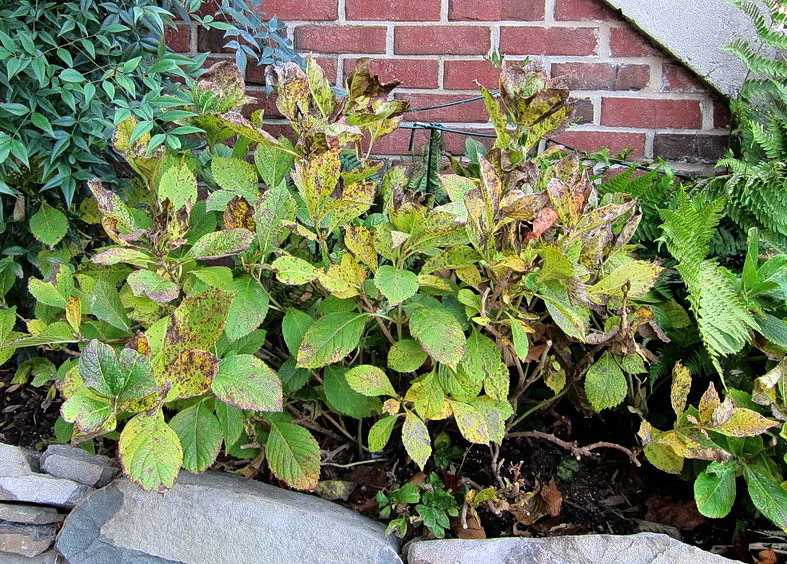5 Easy Facts About Hydrangea Leaves Turning Yellow Shown
Wiki Article
The Buzz on Hydrangea Leaves Turning Yellow
Table of ContentsSome Of Hydrangea Leaves Turning YellowThe Single Strategy To Use For Hydrangea Leaves Turning YellowHydrangea Leaves Turning Yellow for Dummies7 Simple Techniques For Hydrangea Leaves Turning YellowIndicators on Hydrangea Leaves Turning Yellow You Need To KnowMore About Hydrangea Leaves Turning Yellow
These problems are easy to recognize and deal with if you take actions before root rot embed in. A dampness meter can assist direct you to the very best technique of improvement. Huge fallen leaves commonly look sagging during the afternoon warm. When they fall short to cheer up at night or still look wilted in the early morning, your plant might be overwatered.Get rid of the plant from the dirt and prune out any type of origins that aren't white and swollen (plump). Don't try to remedy the trouble by watering exceedingly.

How Hydrangea Leaves Turning Yellow can Save You Time, Stress, and Money.
Initially appears on the older leaves, yet the fallen leave veins remain environment-friendly. While there is typically adequate iron in all-natural dirt, hydrangeas commonly struggle to soak up sufficient of it.The ideal means to stop iron deficiency-chlorosis in hydrangeas is to plant them in ideal ericaceous or acidic dirt. When planting in a bed, mix in some peat or reduced-peat ericaceous garden compost and examine the p, H value annually. This is essential due to the fact that the compost mixture around the plants will influence the p, H value of the soil in the future and the p, H value may increase once more.

Indicators on Hydrangea Leaves Turning Yellow You Need To Know
September is the finest time of year to do something about those hydrangeas. Their fallen leaves are turning yellow, the blossoms have actually discolored, and their gangly look is making you crazy.Currently to deal with the remaining shrub, not a pretty sight as winter season approaches. Mophead, Lacecap and Oakleaf hydrangeas grow on old wood. What that means is they will certainly bloom next year on wood that was formed this year. Do not prune Mophead, Lacecaps and Oakleaf hydrangeas to the ground, as you will certainly get rid of the stems that are ready to flower next spring.
That way you will not be eliminating too many of following year's blossom buds. If the hedge is obtaining larger than you like, you can take out a third of the online wood while you're in there.
A Biased View of Hydrangea Leaves Turning Yellow
We're appropriate in the center of our late-blooming hydrangea period below, so I assumed I would certainly share a tip for this specific sort of hydrangea that I found actually intriguing. A great deal of people have a comparable problem with their panicle hydrangeas where they click here to read begin to see the fallen leaves transforming yellow and handing over at various components of the season and it can be pretty significant and rather worrying because it can occur really quickly on a shrub that feels like it's otherwise truly healthy and balanced.I have actually shared it on Instagram prior to, however I realized I've never ever told you regarding this in a genuine, full post, so today I'm dealing with that. When I claim that this relates to panicle hydrangeas, that means the kind of hydrangeas that commonly grow later on in summertime, normally around August.
Where we live in zone 6, they're rather very easy to have success with and they're actually preferred in our area, which is wonderful since that indicates that there are hydrangeas simply concerning all over right now of year. When you see your hydrangea leaves beginning to transform yellow, you may think that your plant is dying or being abused in some method, but in fact, the opposite holds true.
Some Known Details About Hydrangea Leaves Turning Yellow

Courtenay is the author of the book The Cleansing Ninja and has actually been included in various publications consisting of Nation Sampler Farmhouse Style, Better Homes and Gardens, Parents Magazine, Real Simple, and Our Homes.
Water logged soil denies the origins of oxygen, leading to root rot and yellow leaves. On the other hand, underwatering or dehydration triggers the plant to wilt and its vegetation to yellow. Keeping a constant watering timetable and guaranteeing appropriate drain via drainage openings or layers can help avoid these problems.
Everything about Hydrangea Leaves Turning Yellow
Frequently examine the dirt acidity, and change as required to preserve the optimal p, H level for hydrangeas. With correct care and upkeep, hydrangeas navigate here can grow and maintain their dazzling, vibrant fallen leaves. Hydrangea leaves transforming yellow is a typical concern that can be credited to different aspects. Among the main reasons is incorrect watering, as hydrangeas need continually wet dirt to grow.The kind of yellowing seen (e. g. the placement of the impacted leaves on the plant, and/or the pattern and setting of the yellowing on the fallen leave itself) will commonly vary according to the reason. The chlorosis is often accompanied by various other signs and symptoms providing further go to website ideas as to the reason, e.Instances include sap-sucking insects such as aphids, red spider termites and whiteflies, and origin feeders such as creeping plant weevil and cabbage origin fly. Once more it is usually possible to discover the perpetrator on the fallen leaves or among the origins.
Report this wiki page